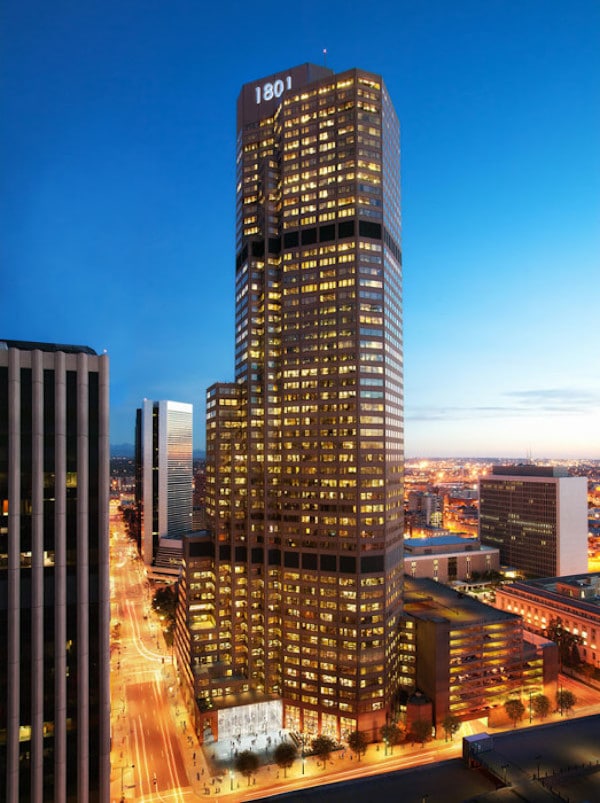Since its construction in 1983, 1801 California Street has stood as one of downtown Denver’s most prominent towers. The second tallest in the Mile-High City, it’s been a large part of Denver’s development—home to the offices of a long list of communications, tech, and energy firms. But in 2011, the upscale property management firm Brookfield Property Partners bought the tower and embarked on a major renovation in 2012, aiming to impact lease signings to improve the building’s occupancy—which, at the time, sat at a meager 25%. Among the company’s top priorities: lighting that could differentiate the building in the eyes of prospective tenants.
To carefully examine a myriad of lighting options, Brookfield turned a vacant suite in another one of its properties into a showroom where they narrowed down the competition. “We bought or borrowed about a dozen different fixtures, after our architects, lighting designer, and electrical engineer reviewed specs for a larger number,” says Pat Hilleary, vice president of Brookfield Property Partners. The team assessed the fixtures for quality and purity of light, energy efficiency, and the overall aesthetic effect the lights had on the office spaces. One fixture stood out for its attractiveness, its innovative energy efficiency, and the value it would add to 1801 California—Ledalite ArcForm by Philips.

Ledalite Arcform is an LED system that provides pure, white light and soft, balanced brightness. It requires extremely low wattage-per-square-foot, warms up quickly, and has a long life. PHOTO: COURTESY OF PHILIPS
BREAKING AWAY FROM THE PACK

Ledalite ArcForm operates at a low 40 watts-per-fixture (compared to the whopping 98 watts for the twin tube fluorescents they replaced) and is able to provide tenants with such high efficiency due in part to its patented MesoOptics technology. The MesoOptics film on the lens allows the luminaires to turn small amounts of controlled brightness into soft light with minimal glare, which improves the appearance of the light while reducing energy consumption.
“It’s like having a bunch of little prisms cut into a piece of film that reflects the light,” explains engineer Brett Pumphrey of BCER, the company Brookfield brought in as the primary mechanical, electrical, and plumbing engineers for 1801 California. “For every three luminaires, we used to need, we now only need two. The price point is a little higher, but when you’re only using two-thirds the amount [of watts], you make that up really quick.”
WHAT YOU NEED TO KNOW ABOUT LIGHTING REBATES:
Consumers can get significant rebates for purchasing energy efficient lighting, like Brookfield did for purchasing Ledalite Arcform. Many lighting companies (including Philips) have comprehensive rebate-finding tools on their websites to simplify the process.
Federal rebates are also available for many EnergyStar labeled lighting products. But new lighting technologies (especially LEDs) are entering the market faster than they can be EnergyStar labeled.
One of the organizations that have taken up that slack is the DesignLights Consortium. They serve as the efficiency-assessing authority, and maintain a Qualified Products List for companies and organizations that want to provide incentives for energy-saving products while they await EnergyStar labeling.
Additional energy savings were captured by using Response daylight harvesting sensors in the ArcForm. Each individual luminaire dims automatically in response to natural daylight. The drivers each operated independently, meaning that the luminaires in an internal hallway would conveniently produce more light than those in a corner office with lots of windows.
At the time of the renovation, most LEDs on the market were merely updates of the luminaires that used to contain fluorescent lamps. Ledalite created a revolutionary, brand-new luminaire with ArcForm, designed around an LED source. “LEDs were still pretty new,” Pumphrey explains. “Many manufacturers were jumping into the market just taking their old luminaires and replacing their fluorescent lamps with new LED strips. Putting a big strip of LEDs where the old fluorescent used to be means that the light is just bouncing around in a cavity and pushing light out whereas the Ledalite was designed to put the light out evenly.”
ULTRA-WIDE DISTRIBUTION = SOFTER LIGHT AND SWEET SAVINGS
Ledalite ArcForm also stood out from the pack because each luminaire was able to provide quality light to a greater area than most other LED fixtures. Due to the ultra-wide distribution, Brookfield was able to space the ArcForms 10’ on center, or one-fixture-per-100-square-feet. This means that fewer fixtures were needed to properly light the space, and resulted in extremely low power densities of about 0.51 watts per-square-foot.
Hilleary explains that this was a deciding factor. “We had narrowed the choice down to two fixtures. At that time the Ledalite was about 30% more expensive than [our second choice], but the Ledalite could adequately cover 100 square feet versus about 65 square feet.”
Ledalite ArcForm is so efficient, in fact, that Brookfield was able to receive a rebate through Xcel Energy, which provides financial incentives for installing products found on the DesignLights Consortium’s Qualified Products List. To give some perspective on just how efficient the fixtures installed at 1801 California were, only about 3% of the indoor luminaires listed on the DLC’s Qualified Products List produce as many lumens as Ledalite ArcForm with the same wattage.
All in all, Ledalite ArcForm allowed Brookfield to create a pleasing office environment by maximizing daylight, minimizing glare, and providing soft, balanced light. The luminaires’ high performance translates into long-term energy savings, which is appealing to any potential tenant. Today, four years after the renovation began, the office spaces at 1801 California are 85% occupied and home to remarkably efficient, truly beautiful places of work.

CONNECT WITH PHILIPS: Website | Facebook | Twitter

